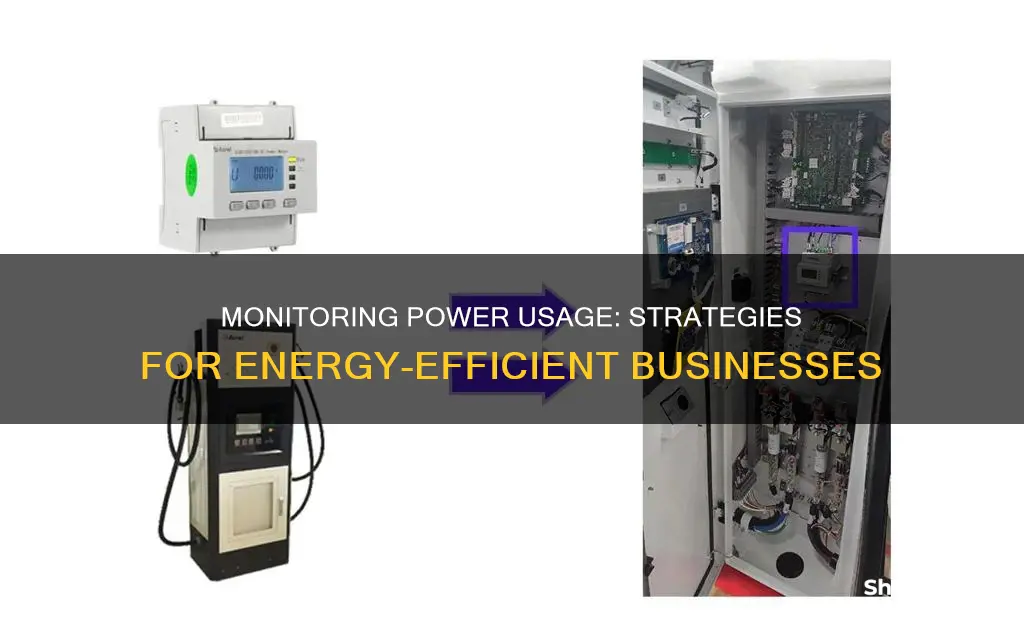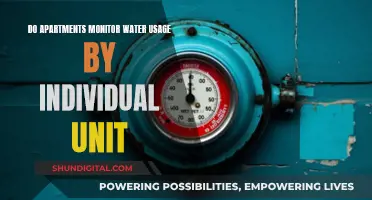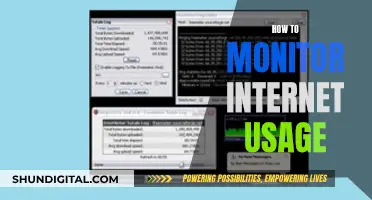
Energy costs are one of the biggest operational costs for any business, but many lack the tools to manage their energy usage effectively. Monitoring power usage is essential for businesses to manage their energy use, costs, and productivity. By understanding how and when equipment uses energy, businesses can identify opportunities to operate more efficiently, reduce energy consumption, and manage energy costs. There are several ways to monitor power usage, including installing gas and electricity meters, using smart meters, and analysing energy data to identify abnormalities and areas for improvement.
| Characteristics | Values |
|---|---|
| Purpose | To save money and reduce carbon footprint |
| Method | Electricity usage monitors, smart plugs, smart meters, wattage meters, software |
| Data | Real-time energy usage and cost data, daily, weekly, monthly, and yearly reports, historical data, bill comparisons and estimates |
| Benefits | Identify opportunities to operate more efficiently, reduce energy use, manage costs, and repair equipment |
| Action | Install gas and electricity meters, monitor and analyse performance, identify energy-saving opportunities |
What You'll Learn

Install gas and electricity meters
If you're expanding your business, moving to a new location, or renovating your current premises, you'll need to consider installing a business energy meter. This will monitor your energy usage, ensuring you don't overpay or underpay for your gas and electricity.
Step 1: Find Your Supply Numbers
First, you'll need to locate your business electricity and gas supply numbers. These are unique identifiers for the supply to your property. You can find the Meter Point Administration Number (MPAN) on your latest electricity bill, and the Meter Point Reference Number (MPRN) on your latest gas bill.
Step 2: Choose Your Meter Type
Next, you'll need to decide on the type of meter you require. Not all meters are the same, so it's important to consult with your supplier or an energy expert to determine the best option for your business. Common types of business energy meters include standard meters, digital meters, variable-rate meters, prepayment meters, and smart meters.
Step 3: Negotiate Installation Costs
While smart meter installations are often free, you may be charged a fee for installing other types of meters, especially if your business consumes a large amount of energy. However, installation costs are typically negotiable, so don't hesitate to discuss and haggle over the price.
Step 4: Book the Installation
Once you've agreed on the type of meter and installation costs, it's time to book your installation appointment. Your energy supplier will assess the work required and arrange a suitable day for the installation. After the meter is fitted, billing will commence based on the terms agreed with your supplier.
Additional Considerations:
If you rent your business premises, the installation of a gas meter may be the responsibility of your landlord. In either case, ensure that the installation is carried out by a qualified and accredited engineer or distributor. For gas meters, this means using a Gas Safe engineer.
The location of the meter is also important. Gas meters should be installed on an external wall, within a certain distance from the corner of the building and in relation to doors and windows. In some cases, such as communal areas in blocks of flats or industrial estates, the meter may need to be fitted inside the building.
Lastly, be prepared for the installation to take some time. It typically takes between five days and two weeks to install a new business energy meter, and even longer if you're adding an additional meter. Therefore, it's recommended to start the process as early as possible.
Monitoring Bandwidth Usage: PRTG's Per-IP Address Insights
You may want to see also

Understand your electricity and gas bills
Understanding your electricity and gas bills is an essential step in managing your business's energy use, costs, and productivity. Here are some detailed steps to help you comprehend your electricity and gas bills:
Analyse Your Energy Profile
Call your energy provider or visit their website to access your energy profile from your smart meter. This profile will provide valuable insights into how much energy your facility consumes. By understanding your energy profile, you can make more informed decisions about your energy usage and identify areas where you can improve efficiency and reduce costs.
Install Gas and Electricity Meters
Consider hiring a registered electrician or plumber to install gas or electricity meters for your equipment. These meters will help you measure the energy consumption of specific devices or areas within your facility. Electricity meters are typically straightforward for electricians to install, while installing gas meters may require partial or complete shutdowns of the plant by a certified plumber.
Different Types of Meters
There are several types of meters available, each serving a specific purpose:
- Smart meters: These meters measure and monitor your facility's gas and electricity usage and display the information online.
- Smart clamp-on energy meters: These meters are designed to measure motor electricity usage specifically.
- Smart submeters: These meters measure the gas and electricity usage of specific equipment.
- Circuit-breaker meters: These meters are used to measure electricity consumption in a particular piece of equipment or area.
Monitor and Analyse Performance
Regularly monitoring your energy usage data is crucial. Assign this task to someone in-house or hire a specialist to audit the data for you. Look for any abnormalities or unexpected spikes in energy consumption, as these can indicate issues with equipment efficiency or potential repair needs. Compare the data to your baseline and business activity to identify opportunities for improvement and cost savings.
Understand Billing Terms and Calculations
Familiarize yourself with the terms and calculations used in your electricity and gas bills. For example, understand the difference between kilowatts (kW) and kilowatt-hours (kWh). kW measures power and how fast it is being used up, while kWh measures energy consumption over a specific period. Understanding these terms will help you better interpret your bills and make more informed decisions about your energy usage.
Monitor Broadband Usage: Track Your Data Usage Easily
You may want to see also

Monitor and analyse performance
Monitoring and analysing performance is key to managing energy use, costs and productivity in your business. It is pointless to meter your energy use if you don't monitor it regularly. Here are some steps to monitor and analyse performance:
Allocate Responsibility
Delegate the task of monitoring to someone in-house, or hire a specialist to audit the data for you.
Look for Abnormalities
Compare the data to your baseline and business activity. This will help identify if equipment is running when it is not needed. For example, you may find that certain equipment is running overnight or over the weekend when it is not required.
Monitor for Unexpected Spikes
Regularly monitor the data for unexpected spikes. These spikes can indicate when equipment needs repairing or maintaining.
Identify Energy-Saving Opportunities
Through your analysis of the energy data, you may come across abnormalities. Find ways to reduce or eliminate them. Consider turning off equipment when it is not needed, and target equipment that uses the most energy. If you don't have the in-house expertise, you can hire a registered electrician, plumber or energy auditor to help identify energy-saving opportunities.
Monitoring Employee Internet Usage: What Employers Can and Can't Do
You may want to see also

Identify energy-saving opportunities
Energy-saving opportunities can be identified by analysing energy data and finding abnormalities. This can be done by using energy-monitoring systems, such as smart meters, which can help to reduce utility costs by up to 30%.
Firstly, it is important to establish a baseline to track and report improvements. This can be done by understanding your electricity and gas bills and analysing your energy profile to determine how much energy your facility uses. This can be done by calling your energy provider or visiting their website.
Next, you can install gas and electricity meters to measure equipment energy use. There are various types of meters available, including smart meters, smart clamp-on energy meters, and circuit-breaker meters. These can be installed by a registered electrician or plumber.
Once you have access to energy data, you can begin to identify opportunities to save energy. For example, you can consider turning off equipment when it is not needed, such as overnight and on weekends. You can also target equipment that uses the most energy and explore energy-saving tips for that specific equipment.
Additionally, you can perform a walk-round survey to identify inefficient equipment and processes. You can also compare your energy usage to that of similar businesses or to industry standards to identify areas where you can improve.
If you do not have the expertise to identify energy-saving opportunities, you can hire a registered electrician, plumber, or energy auditor to assist you.
Monitoring Data Usage: Track Device Consumption
You may want to see also

Upgrade your system with energy-specific finance
Energy-efficient upgrades can be costly, but they are a great way to improve your property's value, make your space more comfortable, and lower your utility bills. There are several ways to finance these upgrades for your business. Here are some options to consider:
Federal, State, and Local Tax Incentives
The U.S. Department of Energy's Office of Energy Efficiency and Renewable Energy offers financial assistance for businesses to develop and implement energy-efficient strategies and technologies. There are also various tax incentives, rebates, grants, loans, and policies related to energy efficiency that you can explore through the Database of State Incentives for Renewables and Efficiency (DSIRE).
Debt and Loans
You can consider taking on debt or applying for loans to finance your energy-efficient upgrades. This could be in the form of a separate loan or tied to a refinance or renovation loan. Credit unions and banks often offer loans for energy-efficient upgrades, and there are also specific programs like the Fannie Mae EnergyLoan® Program.
Energy Efficient Mortgages
If you are a homeowner, you can look into Energy Efficient Mortgages (EEMs) to finance energy-efficient upgrades directly into your mortgage. These are available for conventional, FHA, and VA homebuyers, and allow you to make energy-efficient upgrades more affordable by including them in your mortgage payments.
PACE Financing
Property Assessed Clean Energy (PACE) Financing is not a loan but a property tax lien. It covers a wide range of energy-efficiency upgrades and is tied directly to the property. The amount financed through PACE is typically limited to a percentage of the property's market value, and the repayment period can range from 5 to 20 years.
Home Equity Line of Credit (HELOC)
A HELOC uses your property as collateral and provides a revolving account for financing energy-efficient upgrades and other expenses. It usually has a higher interest rate than a fixed mortgage, and the interest may be tax-deductible.
These are just a few options to consider when upgrading your system with energy-specific finance options. Be sure to explore the various programs, incentives, and financing methods available to find the best fit for your business needs.
University WiFi: Staff Privacy and Monitoring Concerns
You may want to see also
Frequently asked questions
Energy costs are one of the biggest operational costs for any business, and monitoring power usage can help you identify opportunities to operate more efficiently, reduce energy consumption, manage energy costs, and repair equipment as soon as it stops working efficiently.
Call your energy provider or visit their website to check your energy profile from your smart meter. Analyze your energy profile to understand how much energy your facility uses.
You can install gas and electricity meters to measure equipment energy use, or use smart meters, smart clamp-on energy meters, smart submeters, or circuit-breaker meters, depending on your needs.
Regularly monitor your energy usage data for unexpected spikes, which can indicate when equipment needs repairing or maintaining. Compare the data to your baseline and business activity to identify if equipment is running when it doesn't need to be.
Monitoring energy usage can help you manage energy costs, identify opportunities to operate more efficiently, and reduce your business's environmental impact by lowering greenhouse gas emissions.







